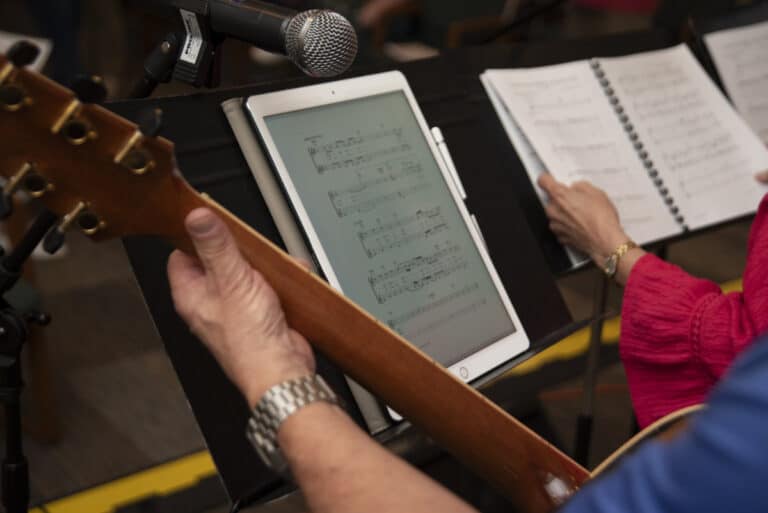Lent — and Advent, for that matter — are seasons in which you want your community to be able to fully immerse in the faith experience. When the distinctive songs of Lent return year after year, they can go deeper into the bones. They become an experience for the body and spirit, not just the mind.
In my parish, we don’t have any new songs planned for Lent. That is not laziness, and it’s not cost containment. It’s an intentional decision during our music planning for Lent.
Does that mean you should never have new music at Lent? Absolutely not. It means you need to choose that music carefully — with the long run in mind — and introduce new songs for the assembly outside of the season. Last year, for example, we introduced “Arrepiéntete/Repent” by Jaime Cortez (OCP) and “Into the Desert” by Curtis Stephan. It’s a contemporary piece from OCP found in Spirit & Song.
Two weeks before Lent, our accompanist played it as an instrumental during the Preparation of Gifts. On the final Sunday before Lent, the ensemble sang it as a prelude and we made the advance connection for the assembly: “Next week, we’ll enter into the desert of Lent together. Here’s a prayerful song that will accompany us during the season.”
Opportunity for reflection
Another way we introduce new music is as a song meant for the assembly to experience without singing. To be honest, we don’t do this often because our community loves to sing. A great example of this, however, is the powerful choral arrangement “Lazarus” by Robert Tanner (GIA). It’s appropriate for the Fifth Sunday in the Cycle A readings for Lent. We’re in Cycle B now in the three-year rotation of Scripture. However, especially in communities with an active RCIA process, Cycle A readings are an option. “Lazarus” is an acapella arrangement and requires a strong tenor to proclaim the retelling of the gospel story.
Ritual-focused pieces
Beyond those rare examples of introducing new music, we rely on a tightly curated repertoire of Lent music. We have four or five gathering songs we rotate, again based on the Scriptural focus for the year, and the opening song is used every week of Lent.
A great option are those songs specifically created for the Gathering Rite. They often have an accompanying penitential rite (Lord, have mercy or kyrie eleison). This creates a unified experience to draw the assembly into the liturgy. Two resources for this are: The Church Gathers by Gary Daigle and Marty Haugen and By Heart from Tony Alonso and Gabe Huck. Both collections are GIA. That said, we also have one or two songs where we use the same approach and vary the verses each week: Trevor Thomson’s and Ed Bolduc’s “Turn Our Hearts Around” (GIA) and similar text in Marty Haugen’s “Turn My Heart, O God” (GIA).
Similarly, we keep things consistent with simple service music used year after year. Stephen Pishner’s Psalm and Gospel Acclamation for Lent is built on the WONDROUS LOVE tune, which is a familiar melody. We wed the communion rite in the same way as the gathering rite, using “Take O Take Me as I Am” from Tony Alonso, Gabe Huck, and John Bell. It adds the breaking rite (Lamb of God) on the front end that flows seamlessly into the communion song. The song is an extension of the familiar Taizé-style piece but with Lenten verses.
Everywhere else in the liturgy, we draw from a list of familiar Lenten songs and psalms we’ve introduced and reinforced over two decades. The aim is always to keep it simple and familiar. This serves not only the community’s experience, but also the needs of the music ministry. We don’t have to spend much time rehearsing for Lent during Lent. Instead, we focus our attention and time on getting ready for the abundant music that follows in Holy Week.
Even if you’ve already completed your music planning for Lent, take another look at it. Are there any opportunities to simplify or reinforce a specific message by repeating a song at closing or during the Preparation of Gifts? Or do you let the Preparation of Gifts be a time for planned silence? Just as in any song, the magic is often in the balance of the melody and the rests.
Written by Kathy Felong, a lifelong liturgical musician and director of Liturgy at Holy Cross Catholic Church in northwestern Pennsylvania.
Copyright © 2024 Catholic Liturgical Ensemble Formation
Looking for more resources? Search our full online library of CLEF Life resources, or sign up for CLEF Life email updates to receive the latest resource in your inbox once a week.



